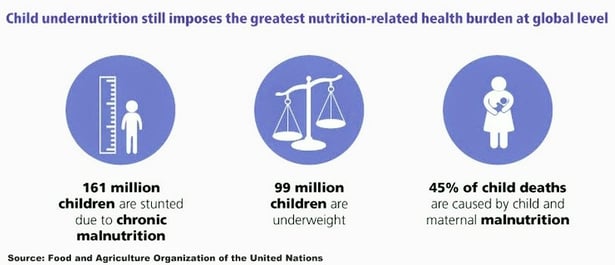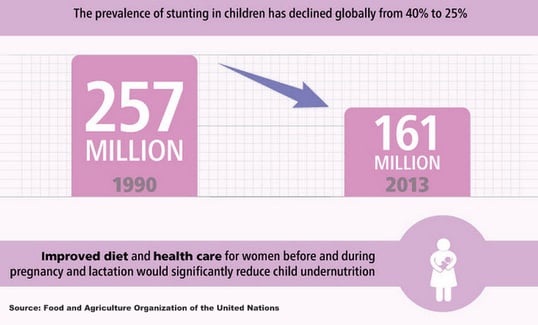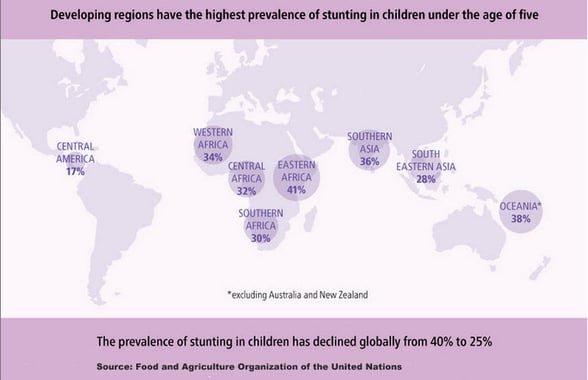-
Dairy Makes a Case as a Remedy for Malnutrition
By Véronique Lagrange May 21, 2015- Tweet
 Speakers at a recent Experimental Biology Conference outline the important role of dairy in childhood nutrition.
Speakers at a recent Experimental Biology Conference outline the important role of dairy in childhood nutrition.Power of Nutrition, a new World Bank-backed charity organization launched in April, succinctly states the task at hand: “Investing in the nutrition of children has the power to trigger huge social and economic changes in countries.”
The group is among a growing number of nutrition organizations focusing its efforts on the problem of stunting, which affects more than 20 million newborns annually, particularly in Africa and regions of Asia.
Stunting has been definitively linked to a variety of ills in developing nations, causing:
-
Nearly half of childhood mortality.
-
Reduced height and physical robustness.
-
Lower cognitive performance, which translates into lower educational success and less likelihood to escape poverty.
-
Increased risk of diseases like high blood pressure, coronary heart disease and diabetes.
-
Reduced lung, kidney and immune system function.
All of it leads to a massive drain on society. The cost of stunting to nations is estimated at 16 percent of GDP.

It doesn’t have to be that way. As Power of Nutrition notes, with the right nutrients and care early on in life, a child’s brain and body are able to grow to their full potential.
A growing body of evidence—built in part by more than five years of progressively more focused clinical and scientific research collaboratively developed between USDEC, Dairy Management Inc. and other partners internationally—supports dairy as a key part of the nutritional solution to stunting, demonstrates dairy’s superiority over alternative sources of proteins, and outlines how dairy functions to prevent the condition.
Organizers at the prestigious Experimental Biology Conference asked USDEC to present the latest scientific findings on the role of protein quality, growth and malnutrition and the role of dairy in food aid at this year’s event in Boston on March 28-April 1. We called the three-hour conference-within-a-conference the “Dairy for Global Nutrition Symposium” and brought in an international group of nutrition experts to present the latest research in the field.
Below is just of sliver of the key themes presented by speakers:
1) Protein quality matters.
Mark Manary, pediatrician at Washington University School of Medicine in St. Louis, Department of Pediatrics, presented groundbreaking research that establishes a strong positive correlation between protein quality scores and rates of weight gain in malnourished children.
Manary reiterated the accuracy of the Digestible Indispensable Amino Acid Score (DIAAS) rather than the old Protein Digestibility Corrected Amino Acid Score (PDCAAS) to measure protein quality. An expert U.N. Food and Agriculture Organization (FAO) consultation determined in 2012 that DIAAS was a better measure of protein quality and reaffirmed those findings in a second report released this March.
DIAAS clearly demonstrates the superiority of dairy proteins compared to plant proteins, measuring a 25-30 percent nutritional advantage over soy and pea protein.

2) The first 1,000 days of life, starting during pregnancy, are critical.
Studies show 30 percent of stunting takes place in utero. Pre-mature babies catch up in terms of growth; low-birth-weight or stunted infants cannot make up for growth and remain small and prone to an array of troubles.
David Clark, Ph.D., founder of Bovina Mountain Consulting, presented a summary of the latest research indicating that moderate dairy intake reduces risk of low birth weight. Short-term nutritional improvement during the first 1,000 days can result—in just one generation—in a gain in adult height of up to 8 cm greater than the mean parent height, noted Clark.
3) Dairy proteins promote growth, but lactose and Type II minerals in dairy—potassium, magnesium and phosphorous—also show promise at reducing the prevalence of stunting.
Benedikte Grenov, Ph.D. candidate in pediatric and internal nutrition, Department of Nutrition, Exercise and Sports at the University of Copenhagen, outlined multiple positive potential effects of lactose, including improved growth, prebiotic properties, dental benefits and the ability to foster mineral absorption.
While the picture of how dairy can help reduce levels of stunting is becoming clearer, Grenov and other speakers emphasized the need for further research. We still need to determine the exact dose of dairy nutrients effective at each and every stage of the first 1,000 days and how to cost optimize the treatments.
We also need to craft a quality statement about protein. FAO is developing guidance documents for policy makers, the industry and the public on dietary protein quality evaluation and the use of DIAAS in making protein-related claims.

The ultimate objective behind this and other elements of USDEC’s Dairy for Global Nutrition initiative are to increase sales of U.S. dairy ingredients in the market-priced, commercial channel, while also supporting international policies for the standard of care for moderate acute malnutrition that include dairy. The ultimate success of the program is to have the World Health Organization and FAO “endorse” dairy in nutrition policies for the first 1,000 days.
The U.S. Dairy Export Council is primarily supported by Dairy Management Inc. through the dairy farmer checkoff that builds on collaborative industry partnerships with processors, trading companies and others to build global demand for U.S. dairy products.
10 Most Recent Posts
Most Popular Posts in Past Year
Index of Posts by Topic
- #GotDairyJobs (4)
- About USDEC (66)
- Africa (6)
- Australia (4)
- Blog (8)
- Brazil (4)
- Canada (20)
- Central America (1)
- Cheese (58)
- Chile (1)
- China (54)
- Common food names (7)
- Company News (20)
- Consistent Supply (1)
- Crisis Management (3)
- Cuba (2)
- Dairy (6)
- Dairy checkoff (9)
- Dairy Ingredients (5)
- Dairy Management Inc. (2)
- Dairy Resources (1)
- Dairy Supply Chain (1)
- Dairy Trends (5)
- Documentation (3)
- EU (24)
- Experts on Dairy Exports (4)
- Exporter of the Year (2)
- Exports (24)
- Farmer leaders (1)
- Farming (38)
- Food Aid (8)
- Food Safety (8)
- Foodservice (3)
- Free trade agreements (34)
- Future trends (1)
- Geographical Indications (GIs) (10)
- Global Marketing (86)
- Global Shipping Crisis (1)
- Got Jobs? (9)
- Indonesia (1)
- Innovation (17)
- Japan (17)
- Krysta Harden (1)
- Market Access (25)
- Market Conditions (268)
- Member Services (17)
- Mexico (41)
- Middle East (9)
- Middle East & North Africa (3)
- Middle East/North Africa (9)
- Milk (4)
- Milk Protein Concentrate (MPC) (2)
- New Zealand (11)
- Next5% (20)
- Nonfat Dry Milk/Skim Milk Powder (8)
- Nutrition (19)
- Product Innovation (6)
- Protein (4)
- Regulations (5)
- Research & Data (326)
- Russia (3)
- Singapore (10)
- South America (8)
- South Korea (10)
- Southeast Asia (25)
- Strategic Insights (1)
- Supply (1)
- Sustainability (26)
- Technology (2)
- ThinkUSADairy (5)
- TPM23 (1)
- TPP (13)
- Traceability (8)
- Trade Barriers (5)
- Trade Data (7)
- Trade Policy (72)
- TTIP (5)
- UHT Milk (7)
- USMCA (2)
- Vietnam (4)
- Whey (6)
- Whey Ingredients (2)
- Whey products (10)
- Whole Milk Powder (WMP) (3)
- World Dairy Expo (1)
- World Milk Day (1)
- Yogurt (1)
Index of Posts by Date, Author
- June 2021 (13)
- March 2015 (12)
- September 2015 (12)
- April 2015 (11)
- December 2015 (11)
- March 2014 (10)
- February 2015 (10)
- October 2015 (10)
- October 2014 (9)
- June 2015 (9)
- July 2015 (9)
- November 2015 (9)
- March 2016 (9)
- October 2019 (9)
- September 2013 (8)
- May 2015 (8)
- August 2015 (8)
- January 2016 (8)
- February 2016 (8)
- March 2017 (8)
- December 2018 (8)
- May 2019 (8)
- December 2019 (8)
- June 2014 (7)
- November 2016 (7)
- May 2017 (7)
- May 2018 (7)
- July 2020 (7)
- June 2023 (7)
- July 2016 (6)
- August 2018 (6)
- October 2018 (6)
- November 2018 (6)
- February 2019 (6)
- June 2019 (6)
- August 2019 (6)
- March 2020 (6)
- April 2020 (6)
- June 2020 (6)
- June 2022 (6)
- February 2014 (5)
- June 2016 (5)
- August 2016 (5)
- September 2016 (5)
- December 2016 (5)
- February 2017 (5)
- July 2017 (5)
- October 2017 (5)
- January 2018 (5)
- April 2018 (5)
- June 2018 (5)
- July 2018 (5)
- September 2018 (5)
- January 2019 (5)
- March 2019 (5)
- April 2019 (5)
- July 2019 (5)
- September 2019 (5)
- November 2019 (5)
- January 2020 (5)
- August 2020 (5)
- October 2020 (5)
- April 2021 (5)
- January 2022 (5)
- May 2013 (4)
- September 2014 (4)
- April 2016 (4)
- May 2016 (4)
- October 2016 (4)
- January 2017 (4)
- April 2017 (4)
- June 2017 (4)
- August 2017 (4)
- September 2017 (4)
- December 2017 (4)
- February 2018 (4)
- February 2020 (4)
- May 2020 (4)
- February 2022 (4)
- September 2022 (4)
- April 2023 (4)
- December 2023 (4)
- November 2017 (3)
- March 2018 (3)
- September 2020 (3)
- December 2020 (3)
- February 2021 (3)
- May 2021 (3)
- August 2021 (3)
- December 2021 (3)
- March 2022 (3)
- April 2022 (3)
- May 2022 (3)
- October 2022 (3)
- December 2022 (3)
- May 2023 (3)
- July 2023 (3)
- November 2023 (3)
- March 2011 (2)
- June 2011 (2)
- September 2011 (2)
- March 2012 (2)
- June 2012 (2)
- July 2012 (2)
- March 2013 (2)
- July 2013 (2)
- November 2020 (2)
- January 2021 (2)
- March 2021 (2)
- July 2021 (2)
- September 2021 (2)
- October 2021 (2)
- November 2021 (2)
- July 2022 (2)
- August 2022 (2)
- January 2023 (2)
- March 2023 (2)
- October 2023 (2)
- January 2024 (2)
- February 2024 (2)
- April 2024 (2)
- June 2024 (2)
- July 2024 (2)
- November 2024 (2)
- December 2024 (2)
- February 2025 (2)
- June 2025 (2)
- July 2025 (2)
- September 2025 (2)
- November 2025 (2)
- December 2025 (2)
- January 2010 (1)
- February 2010 (1)
- March 2010 (1)
- April 2010 (1)
- May 2010 (1)
- June 2010 (1)
- July 2010 (1)
- August 2010 (1)
- September 2010 (1)
- October 2010 (1)
- November 2010 (1)
- December 2010 (1)
- January 2011 (1)
- February 2011 (1)
- April 2011 (1)
- May 2011 (1)
- July 2011 (1)
- August 2011 (1)
- October 2011 (1)
- November 2011 (1)
- December 2011 (1)
- January 2012 (1)
- February 2012 (1)
- April 2012 (1)
- August 2012 (1)
- September 2012 (1)
- October 2012 (1)
- November 2012 (1)
- December 2012 (1)
- January 2013 (1)
- February 2013 (1)
- April 2013 (1)
- June 2013 (1)
- August 2013 (1)
- October 2013 (1)
- November 2013 (1)
- December 2013 (1)
- January 2014 (1)
- April 2014 (1)
- May 2014 (1)
- November 2022 (1)
- February 2023 (1)
- August 2023 (1)
- September 2023 (1)
- March 2024 (1)
- May 2024 (1)
- August 2024 (1)
- September 2024 (1)
- October 2024 (1)
- January 2025 (1)
- March 2025 (1)
- April 2025 (1)
- May 2025 (1)
- August 2025 (1)
- USDEC (183)
- USDEC Staff (164)
- Alan Levitt (119)
- Tom Suber (41)
- Margaret Speich (22)
- Marc A.H. Beck (15)
- Vikki Nicholson-West (11)
- Angélique Hollister (11)
- Tom Vilsack (8)
- Jaime Castaneda (7)
- Matt McKnight (7)
- Véronique Lagrange (7)
- Margaret Speich and Mark O'Keefe (7)
- Ross Christieson (7)
- Paul Rogers (6)
- Shawna Morris (5)
- William Loux (5)
- Alan Levitt and Marc Beck (5)
- Krysta Harden (4)
- USDEC Communications (3)
- Kristi Saitama (3)
- Marilyn Hershey (3)
- Brad Gehrke (3)
- Tom Quaife (2)
- Nick Gardner (2)
- Jim Mulhern (2)
- Alan Levitt and William Loux (2)
- Kara McDonald (2)
- Luke Waring (2)
- Merle McNeil (2)
- Andrei Mikhalevsky (1)
- Rodrigo Fernandez (1)
- Dermot Carey (1)
- Jeremy Travis (1)
- Annie Bienvenue (1)
- Ross Christieson and Shawna Morris (1)
- Becky Nyman (1)
- Paul Rogers and Tom Quaife (1)
- Rick Ortman (1)
- Tony Rice (1)
- Barbara O’Brien (1)
- Paul Rogers and Mark O'Keefe (1)
- Dalilah Ghazalay (1)
- Amy Wagner (1)
- Mitchell Bowling (1)
- Erica Louder (1)
- Brad Scott (1)
- Amy Foor (1)
- Scott Lantz (1)
- Sandra Benson (1)
- Errico Auricchio (1)
- Jaclyn Krymowski (1)
- Krysta Harden, USDEC President and CEO (1)
.png)

